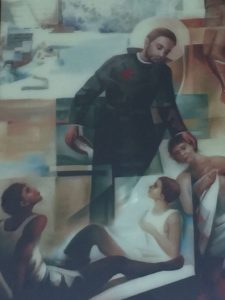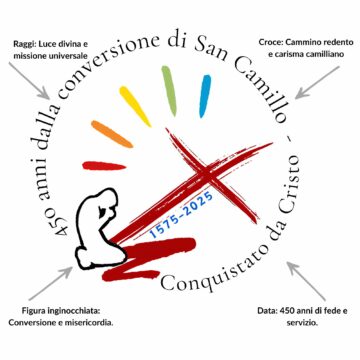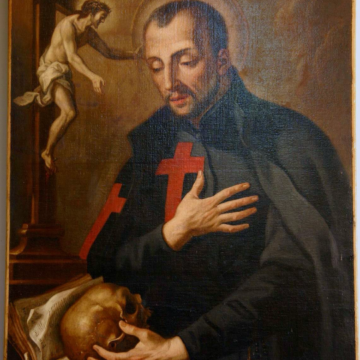di p. Leocir Pessini in Missione Salute Anno XXX – N.1 GENNAIO FEBBRAIO
We live in times charged with uncertainty; times that are marked by fearful disappointments, by a terrible lack of interest, and by a fatal indifference towards human life. We urgently need to retrieve the enchantment and the responsibility of ‘taking care’ of human life as ‘Good Samaritans’. Camillus de Lellis is a great human and divine icon who for four centuries has been an inspiring figure in the ‘art of care’ for all professionals who work in the world of health and health care. Let us try to bring out some of the characteristics of this authentic ‘art of care’.
Love for the sick
Camillus said that the poor and the sick are the very heart and pupils of God: in them we serve Jesus Christ. In his testament, Camillus exhorted his disciples to keep faithful to choosing the poorest and the sick, with all the requirements that this commitment involves. Faced with the large number of mercenaries who, without any specific training, were entrusted with caring for the sick in the hospitals of his time, Camillus produced his famous phrase ‘put more heart in those hands’.
Caring with female sensitivity
To those who worked with him in the field of health care, Camillus said: ‘First everyone should ask the Lord to be given the grace of motherly affection for their neighbour: so we can serve him with all charity both of our souls and our bodies because we wish (with the grace of God) to serve all sick people with that affection that a loving mother usually has for her sick only child’ (from ‘Ordini et modi che si hanno da tenere nelli hospitali in servire li poveri infermi’ – ‘Orders and Ways that should be Applied in hospitals when Serving Sick Poor People’ – n. XXVII).
Total care for the person (body and spirit) and unconditional welcome
Camillus was more attentive to human needs than to the needs of the Church. The Church usually laid down that sick people before entering a hospital had to go to confession. Camillus fought against this rule, saying that one had first to be attentive to the needs of care and then, subsequently, always respecting the freedom of each patient, draw them near to the sacrament of reconciliation. Camillus wanted his fellow religious to provide overall care to sick people. Hospitality was a virtue that was always present in his heart. During epidemics, when the hospitals were crowded, Camillus opened churches and houses so that the sick could have a roof over their heads.
Liturgy at the foot of the bed (of the sick)
 For Camillus, the real ‘liturgy’ was celebrated at the foot of the bed of a sick person. Everything that was done for a sick person, for Camillus had a sacramental dimension. One could say that for Camillus making beds was liturgy; feeding patients was liturgy; and being at the side of those who were about to die was liturgy. These were all acts of love that were transformed into a sacramental action of ‘taking care’ of people. Cutting the hair of patients, combing hair, cutting nails, washing feet, drying shirts marked by sweat, cauterising wounds, wetting lips, putting some drops of vinegar under people’s nostrils, washing and drying hands, putting food into the mouths of patients, and all the other acts of care, were liturgical rites. One of his most famous sayings was: ‘that prayer which cuts the arms of charity is not good’.
For Camillus, the real ‘liturgy’ was celebrated at the foot of the bed of a sick person. Everything that was done for a sick person, for Camillus had a sacramental dimension. One could say that for Camillus making beds was liturgy; feeding patients was liturgy; and being at the side of those who were about to die was liturgy. These were all acts of love that were transformed into a sacramental action of ‘taking care’ of people. Cutting the hair of patients, combing hair, cutting nails, washing feet, drying shirts marked by sweat, cauterising wounds, wetting lips, putting some drops of vinegar under people’s nostrils, washing and drying hands, putting food into the mouths of patients, and all the other acts of care, were liturgical rites. One of his most famous sayings was: ‘that prayer which cuts the arms of charity is not good’.
Educating in caring with tenderness
Camillus saw, felt and suffered because of the presence of mercenaries who worked in hospitals without taking care of the patients in a good way. He taught his disciples, by example, the correct form of care. Thus it was that Camillian institutions were seen as a ‘school of charity’ and gave proof of this both to those who worked in them and to the patients.
In this epoch of ours where increasing attention is paid to the economic dimension of things, with the heart being excluded in the provision of care and treatment, we run the risk of losing this original sensitivity and insight of Camillus.
Ethics and aesthetics united
Camillus appreciated music in a totally special way and willingly went to churches where melodies could be heard. Thus he was led to compare care and treatment for sick people with a musical symphony. He said: ‘When in a hospital many patients call for me at the same time, I seem to listen to music…Father, give me a little water to refresh my mouth…Arrange my bed…warm my feet’.
This should be music pleasing to the Ministers of the Sick as well. Equally, he asked his disciples to have a certain artistic talent by drawing near to the beds of patients with tenderness, without making a noise, walking in the corridors amongst the beds without dragging their feet, almost with dance steps.
One of the greatest creations of this artist and genius of charity was that he introduced the idea of beauty into caring for the sick.
Leocir Pessini











